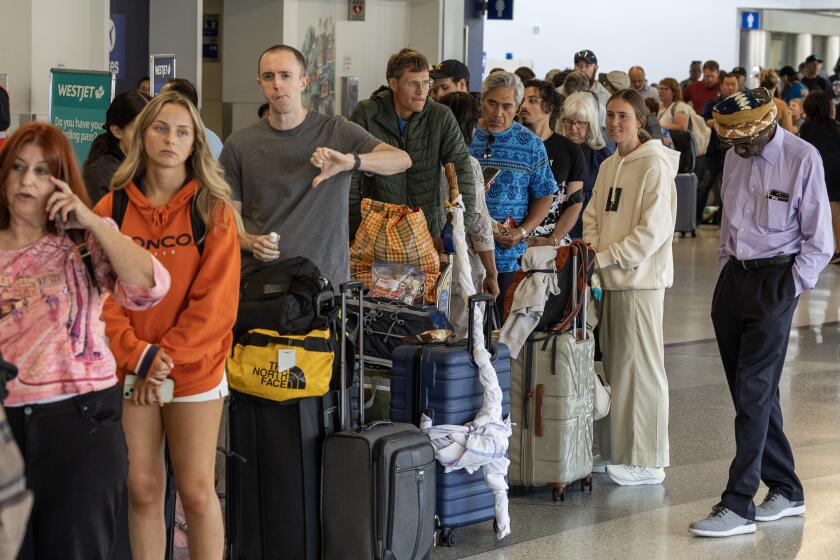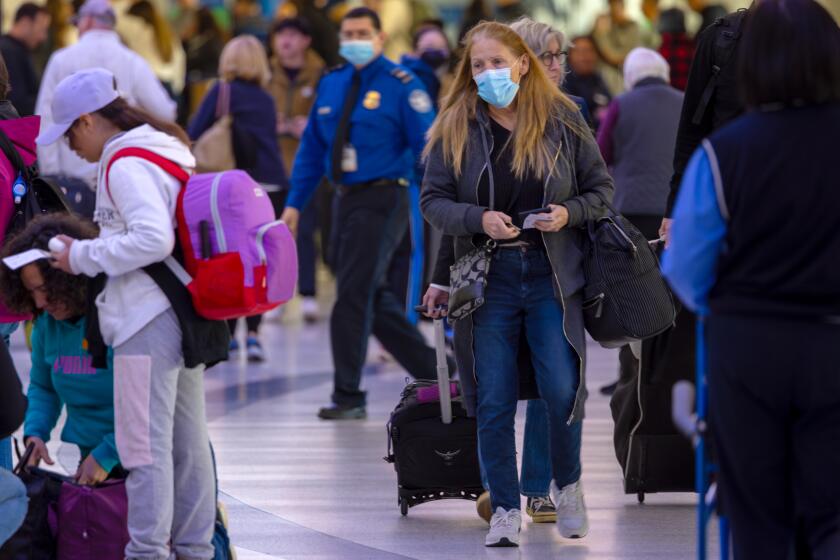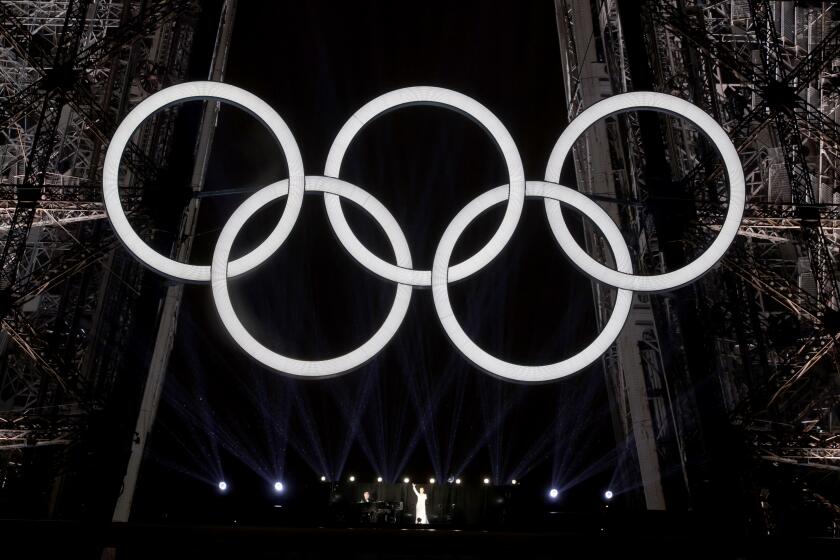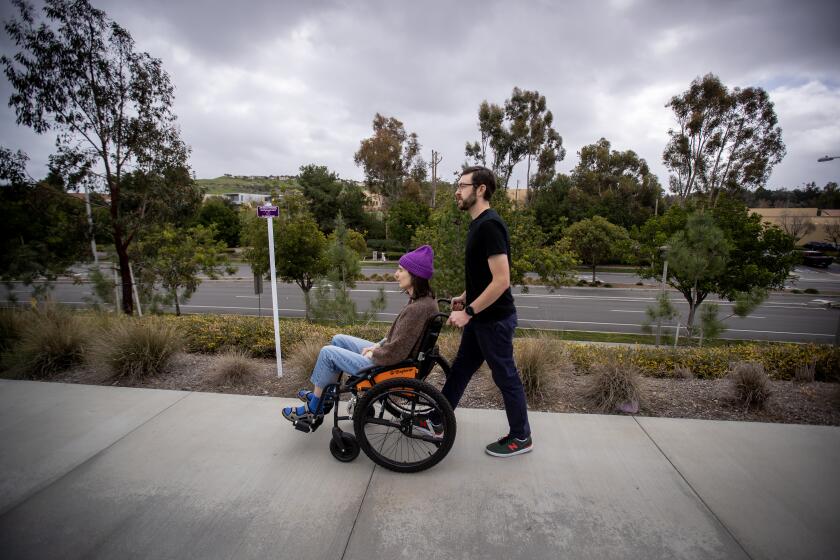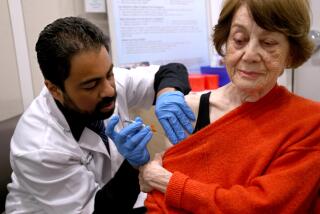COVID surging in California, nears two-year summer high. ‘Almost everybody has it’

- Share via
If it seems like many people around you are getting COVID-19, you’re not alone.
Federal data show coronavirus levels in California’s wastewater are surging to levels not seen in summertime since 2022, indicating a wide and worsening spread of COVID.
“We are seeing ... a definite, definite surge,” said Dr. Elizabeth Hudson, regional chief of infectious disease at Kaiser Permanente Southern California.
The surge is clearly apparent in doctor’s offices and clinics where people are seeking outpatient treatment, Hudson said. But, thankfully, not many people are having to be hospitalized because of COVID-19 at this point.
“The wastewater numbers are still headed up. So we’re definitely seeing more and more cases,” Hudson said.
Coronavirus levels in California’s wastewater now exceed last summer’s peak, an indication of the ready spread of the super-contagious new FLiRT strains.
She urged people to test for COVID-19 if they have respiratory symptoms.
“If you have cough-and-cold symptoms, at this point, living in Los Angeles, you should really think that they are COVID until proven otherwise,” she said.
This latest surge is being fueled in large part by the FLiRT variants — a collection of highly transmissible sibling strains that have out-muscled last winter’s dominant strain, JN.1.
In particular, one of the FLiRT strains, known as KP.3.1.1, “has really taken off,” Hudson said. The U.S. Centers for Disease Control and Prevention estimates that that strain accounted for 17.7% of coronavirus samples nationwide for the two-week period that ended July 20, up from 6.8% for the prior comparable period.
At that rate of growth, that strain is likely to become increasingly dominant in the next few weeks, Hudson said. “So, unfortunately, I think we are going to see a lot more cases.”
In years past, summer travel and gatherings have spurred surges in coronavirus infections. As immunity wanes for those who received the most recent vaccine, experts urge caution.
Coronavirus levels in California sewage are considered “very high” for a third consecutive week, the CDC said Friday. Thirty-seven states and the District of Columbia — home to nearly 3 in 4 Americans — have either “high” or “very high” coronavirus levels in wastewater.
For the seven-day period that ended July 20, the most recent data available, coronavirus levels in California wastewater were at 93% of the peak from the summer of 2022. They’ve already exceeded last summer’s height.
And there are indications that this summer’s COVID-19 wave might have some staying power. Coronavirus levels in California wastewater have been “high” or “very high” for seven straight weeks, with no sign of cresting. The wave from the summer of 2022 played out over 16 weeks during which viral levels were “high” or “very high,” and last summer’s wave lasted eight weeks.
The proliferation of the FLiRT variants may lengthen this summer’s surge, experts say, since they show a particular knack for immune evasion.
“It does seem like we are spitting out more and more variants a lot more quickly, and that’s probably to be expected,” Hudson said. “This virus is still very, very new to humans, and the virus wants to live, and the way that it lives is by evading immunity” — circumventing people’s defenses by evolving in a way to keep the chain of infection going.
Also, “things are pretty much back to normal,” Hudson said, with many people abandoning their once-cautious pandemic behaviors.
Read analysis of the Paris Olympics opening ceremony from our television writers, who weighed in on the spectacle held on the Seine.
Even at the Olympics in Paris, COVID-19 is now treated like any other respiratory illness. The protocol among infected athletes is — if they’re feeling well enough to train — to have them wear masks, isolate when they’re not training and avoid certain communal areas such as the gym.
Regions across California are reporting high coronavirus levels in sewage. In the San Francisco Bay Area, San José and Palo Alto have generally had high coronavirus levels since the end of May. Fresno County health officials said last week that coronavirus levels were high across the San Joaquin Valley.
The rate at which California’s COVID-19 tests are turning up positive has now exceeded last summer’s peak. For the seven-day period that ended July 22, 13.8% of coronavirus tests came back positive. That exceeds last summer’s maximum of 13.1%.
Anecdotally, there are many reports of people getting COVID-19 from events including weddings, work meetings and flights, causing symptoms strong enough to make them miserable for days. Some have been surprised by nastier symptoms this time around compared with earlier bouts of COVID-19, although there are no indications that the latest subvariants result in more severe illness overall.
Those who are older or immunocompromised remain at highest risk.
Hundreds of COVID-19 deaths are still reported nationally every week. Among those who have recently died of complications from COVID-19 and pneumonia was the journalist Dan Collins, 80, who co-wrote “Grand Illusion: The Untold Story of Rudy Giuliani and 9/11.”
His wife, New York Times columnist Gail Collins, wrote that she and her husband both got COVID-19. “It felt like a bad cold on my end, but Dan woke up one night unable to breathe at all. We went to the closest hospital’s intensive care unit, and he never recovered,” she wrote.
COVID cases and hospitalizations rise in L.A. County — and some of those recently reinfected with the FLiRT variants are finding the latest bout the worst yet.
Overall, deaths and hospitalizations from COVID appear to be lower than those last summer.
In Los Angeles County, the nation’s most populous, there were an average of 286 COVID-19-positive people in hospitals for the week that ended July 20. That’s flat from the prior week’s figure of 291, and about half as many as last summer’s peak and one-quarter as many as the peak of summer 2022.
At UC San Francisco, COVID-19 hospitalizations seem to have stabilized, but “there’s a lot of COVID outside the hospital. Almost everybody has it: There’s been outbreaks at, you know, music gatherings and people’s dinners,” said Dr. Peter Chin-Hong, an infectious diseases expert there.
There may be several reasons behind the initial signs of hospitalizations stabilizing, Chin-Hong said. In general, population immunity against COVID-19 is higher. Also, it’s possible that the introduction of COVID-19 antiviral pills such as Paxlovid and its widespread availability may be keeping at-risk people from the hospital.
But with COVID-19 infections growing or likely growing in 35 states, as well as the nation’s capital, Chin-Hong suggested that higher-risk people who aren’t up-to-date on their COVID-19 vaccine should get it now, and not wait until the updated autumn version becomes available.
Everyone age 6 months and above should have received an updated COVID-19 vaccination starting in September, according to CDC guidelines. Those 65 and older should have received a second vaccination dose four months after their first updated dose. Many seniors, however, haven’t had even a single updated dose.
Immunocompromised people should have received one or two doses of the updated vaccine since September, and may get additional vaccine doses two months after their last recommended dose.
“It’s not showing any signs that it’s going down,” Chin-Hong said of the COVID-19 wave. “It’s a good idea for those who are older or immune-compromised to still get it right now. Because by now, I would have thought that COVID would be plateauing and going down, but it doesn’t seem that way — probably, because the rest of the country has caught up” with states such as California.
COVID’s spread is being aided by people who are still going to work or traveling while sick. Doctors say it’s important for people who are sick to avoid putting others at risk.
In only one state, Hawaii, did the CDC estimate that COVID-19 is likely to be declining.
By a number of metrics, COVID-19 indicators are continuing to rise in L.A. County. For the week that ended July 21, L.A. County reported an average of 413 cases a day, up from 359 the prior week. Officially reported cases are considered an undercount, as they don’t account for at-home tests or the fact that fewer people are testing in general, but the figures are still helpful in understanding transmission trends.
Coronavirus levels in L.A. County wastewater were at 40% of last winter’s peak over the 10-day period that ended July 13. That’s up from 36% for the 10-day period that ended July 6.
For the weekly period that ended July 21, 3.4% of emergency-room visits in L.A. County were related to the coronavirus. That’s up from 2.8% for the prior week.
Hudson encouraged people to test repeatedly if they have symptoms of COVID-19, even as far as the fifth day after the onset of illness. People who feel sick might test negative over the first or second days of symptoms, but may end up testing positive later on.
Knowing whether you have COVID is important, “because if you don’t think you have COVID, you may go back to your regular activities — you may go to work — and not wear a mask. And unfortunately, that is going to be a very easy way to continue to spread COVID,” Hudson said.
The prevalence of long COVID has declined since the start of the pandemic, a new study found, but each new infection carries a risk of developing enduring symptoms.
The CDC urges people to stay home and away from others if they’re sick. People can resume normal activities 24 hours after their symptoms have improved and they’ve been fever-free without using medicine such as Tylenol or Advil. But the CDC also advises added precautions for five additional days to avoid infecting others, such as wearing a mask and keeping distance from others.
The Los Angeles County Department of Public Health suggests that infected people who have symptoms get a negative test result before leaving isolation. The agency also suggests that people who are infected — whether or not they have symptoms — wear a mask around others for 10 days after they start feeling sick or, if asymptomatic, get their first positive test result. However, they can remove their mask sooner if they have two sequential negative tests at least one day apart.
L.A. County also suggests that those who are infected avoid contact with high-risk people for 10 days after the onset of symptoms or their first positive test result.
If patients recover and then get sick again, they may have COVID rebound and need to isolate.
For people who want to avoid getting COVID-19, wearing a mask in indoor public settings reduces the risk of infection. The strategy can be particularly effective when traveling, such as on a plane. Travel is “a very common, common way that we are seeing people get exposed,” Hudson said.
It’s still wise to take prudent measures to avoid getting COVID-19, including avoiding sick people, doctors say. Each new infection carries the risk of long COVID-19 — when someone develops enduring, sometimes punishing symptoms that can persist months or years after an infection.
The risk of getting long COVID-19 has decreased since the start of the pandemic, in part thanks to vaccines. But the risk of getting long COVID-19 still remains significant.
“There are still people that do get long COVID,” Hudson said. “And long COVID is something that we all want to avoid.”
More to Read
Sign up for Essential California
The most important California stories and recommendations in your inbox every morning.
You may occasionally receive promotional content from the Los Angeles Times.
